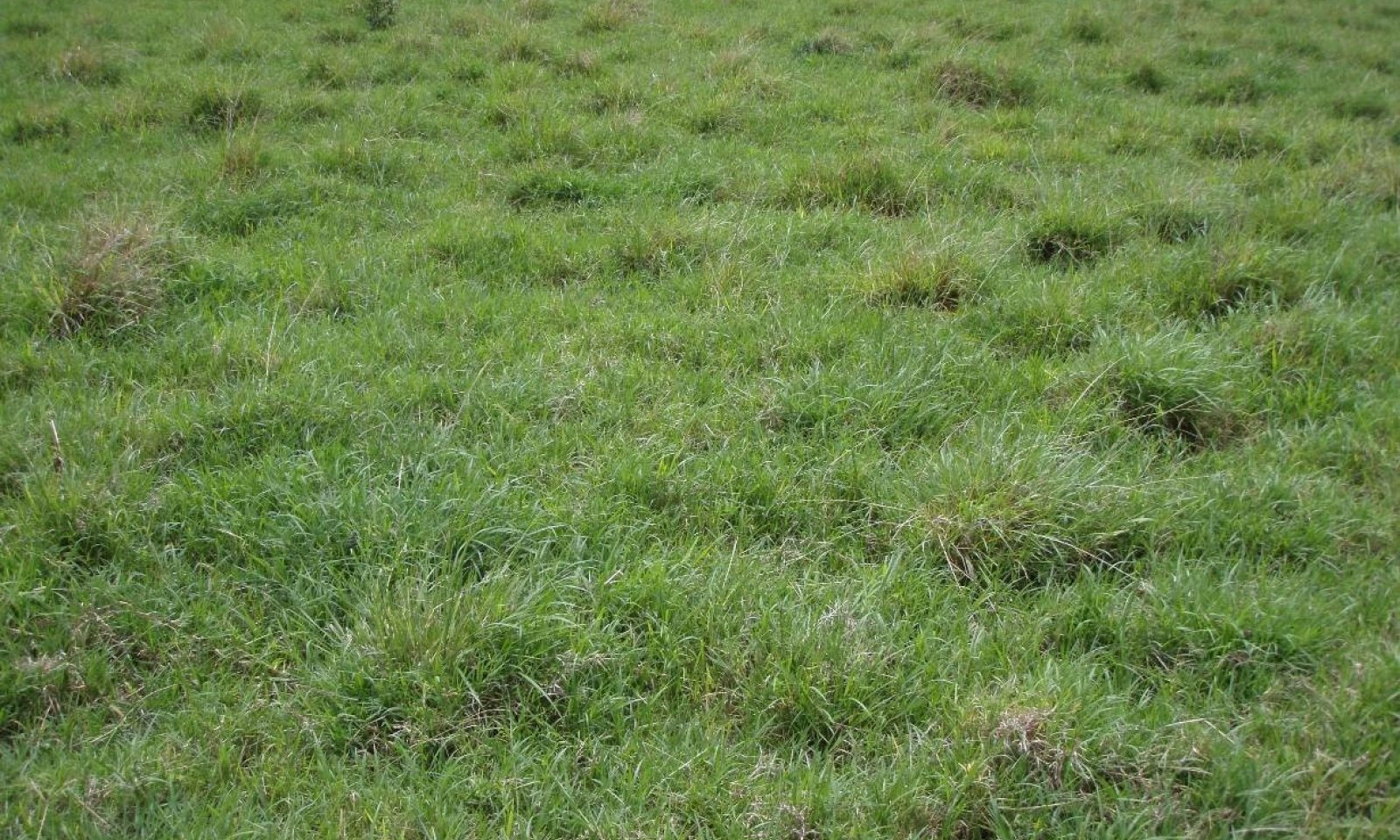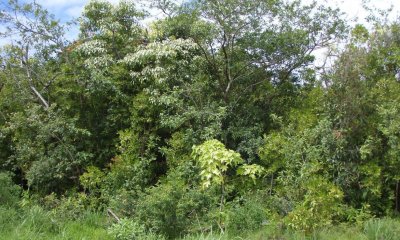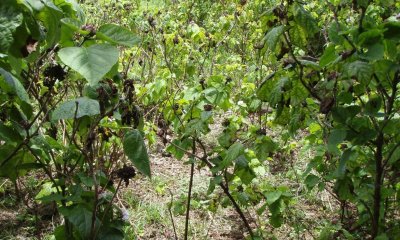
Isohyperthermic Perudic Naturalized Grassland (Guineagrass - Californiagrass)
Scenario model
Current ecosystem state
Select a state
Management practices/drivers
Select a transition or restoration pathway
-
Transition T1A
State 1 Reference transitions to State 5 Weed Invaded Grassland by long-term continuous grazing and lack of weed control measures. Remnant desirable forages have been grazed out and replaced entirely by weedy grasses, forbs, shrubs, and small trees.
More details -
Restoration pathway R2B
State 2 Invaded Understory can be restored to State 1 Reference by clearing the forest with heavy machinery and planting desirable forage species. Native forest may be cleared gradually by allowing cattle access to the forest. Cattle eventually eat or destroy understory ferns, forbs, shrubs, and saplings, opening up the forest so that introduced forage species will thrive.
More details -
Transition T2a
State 2 Invaded Understory State transitions to State 3 Invaded Over and Understory through the process of fast-growing weeds inhibiting reproduction of native plants and gradually replacing them. This process is accelerated by feral pigs and cattle directly damaging native plants and promoting the spread of weeds by disturbing the soil and spreading weed seeds.
More details -
Restoration pathway R2A
State 2 Invade Understory may be restored to a facsimile of State 4 Native Forest. Pig-proof and deer-proof fence and removal of all ungulates are necessary. Intensive weed control must then be initiated and maintained in the long term. In some cases, large amounts of dead weed biomass must be dealt with by removal or decomposition. Reintroduction of missing native species will be necessary.
More details -
Restoration pathway R3A
State 3 Invaded Over and Understory can be converted to State 1 Reference by clearing vegetation using heavy machinery, applying aggressive weed control measures, and planting desirable forage species.
More details -
Transition T4B
State 4 Native Forest can transition to State 1 Reference by clearing the forest with heavy machinery and planting desirable pasture species. Native forest may be cleared gradually by allowing cattle access to the forest. Cattle eventually eat or destroy understory ferns, forbs, shrubs, and saplings, opening up the forest so that introduced grasses will thrive.
More details -
Transition T4A
State 4 Native Forest transitions to State 2 Invaded Understory by the very aggressive, introduced weed species present in this ecological site invading intact native forest and gradually replacing native species in the understory. This invasion is facilitated by feral pigs and cattle that damage and consume native plants, disturb the soil, and spread weed seeds.
More details -
Restoration pathway R5A
State 5 Weed Invaded Grassland can be restored to State 1 Reference by brush management, re-establishment of desirable forage species, persistent weed control, and prescribed grazing.
More details - Transition T5A More details
-
No transition or restoration pathway between the selected states has been described
Target ecosystem state
Select a state
State 1
Reference State





Description
This state consists of two community phases dominated by introduced grass species. Continuous grazing results in increased abundance of less desirable forage species, as represented by the phase change from 1.1 Guineagrass - Californiagrass to 1.2 Hilograss – rat-tail grass. Longer-term overgrazing and lack of weed control measures results in a transition to State 5 Weed-Invaded Grassland.
Submodel
Description
This state consists of one community phase. Native ohia lehua trees dominate the overstory. However, introduced trees, shrubs, vines, and ferns produce a dense layer of low, competitive vegetation that severely inhibits reproduction of native species. Native species are still present in this plant community, but their abundance is much reduced. Activity of feral pigs and cattle further reduces native plant abundance and produces bare, disturbed soil patches that promote weed invasion. Eventually, this state transitions to State 3 Invaded Overstory and Understory through growth of introduced tree species.
Submodel
Description
This state consists of one community phase dominated by introduced species in both the overstory and understory. Some individual native trees may persist for their lifetime. The diversity of weedy trees, shrubs, vines, ferns, and herbs is high, and the species mix is variable. Conversion to State 1 Reference is possible by using heavy machinery and applying aggressive weed control measures.
Submodel
Description
This state consists of one community phase. It is a forest with a tall (to about 80 feet or 25 meters), closed to open overstory, a secondary canopy of diverse trees species 25 to 40 feet (8 to 12 meters) tall, an open tree fern canopy 10 to 15 feet (3 to 4.5 meters) tall, and a diverse understory of shrubs, vines, and ferns.
When cleared by machinery or long-term, heavy ungulate browsing, this state transitions to State 1 Reference. Gradual invasion by weedy, introduced plant species brings a transition to State 2 Invaded Understory.
Submodel
State 5
Weed Invaded Grassland State




Description
This state consists of one community phase consisting primarily of weedy shrubs and small trees. Weedy grasses and forbs dominate between shrub patches. Introduced tree species are present and becoming more abundant attain dominance in the absence of disturbance. Mechanical clearing is the most typical mechanism to keep introduced trees in check as natural fires rarely carry in these wet environments. Average annual rainfall is relatively high, producing large amounts of fine fuels that present a fire danger in rare dry periods.
Submodel
Mechanism
State 1 Reference transitions to State 5 Weed Invaded Grassland by long-term continuous grazing and lack of weed control measures. Remnant desirable forages have been grazed out and replaced entirely by weedy grasses, forbs, shrubs, and small trees.
Mechanism
State 2 Invaded Understory can be restored to State 1 Reference by clearing the forest with heavy machinery and planting desirable forage species. Native forest may be cleared gradually by allowing cattle access to the forest. Cattle eventually eat or destroy understory ferns, forbs, shrubs, and saplings, opening up the forest so that introduced forage species will thrive.
Mechanism
State 2 Invaded Understory State transitions to State 3 Invaded Over and Understory through the process of fast-growing weeds inhibiting reproduction of native plants and gradually replacing them. This process is accelerated by feral pigs and cattle directly damaging native plants and promoting the spread of weeds by disturbing the soil and spreading weed seeds.
Mechanism
State 2 Invade Understory may be restored to a facsimile of State 4 Native Forest. Pig-proof and deer-proof fence and removal of all ungulates are necessary. Intensive weed control must then be initiated and maintained in the long term. In some cases, large amounts of dead weed biomass must be dealt with by removal or decomposition. Reintroduction of missing native species will be necessary.
Mechanism
State 3 Invaded Over and Understory can be converted to State 1 Reference by clearing vegetation using heavy machinery, applying aggressive weed control measures, and planting desirable forage species.
Mechanism
State 4 Native Forest can transition to State 1 Reference by clearing the forest with heavy machinery and planting desirable pasture species. Native forest may be cleared gradually by allowing cattle access to the forest. Cattle eventually eat or destroy understory ferns, forbs, shrubs, and saplings, opening up the forest so that introduced grasses will thrive.
Mechanism
State 4 Native Forest transitions to State 2 Invaded Understory by the very aggressive, introduced weed species present in this ecological site invading intact native forest and gradually replacing native species in the understory. This invasion is facilitated by feral pigs and cattle that damage and consume native plants, disturb the soil, and spread weed seeds.
Mechanism
State 5 Weed Invaded Grassland can be restored to State 1 Reference by brush management, re-establishment of desirable forage species, persistent weed control, and prescribed grazing.
Model keys
Briefcase
Add ecological sites and Major Land Resource Areas to your briefcase by clicking on the briefcase (![]() ) icon wherever it occurs. Drag and drop items to reorder. Cookies are used to store briefcase items between browsing sessions. Because of this, the number of items that can be added to your briefcase is limited, and briefcase items added on one device and browser cannot be accessed from another device or browser. Users who do not wish to place cookies on their devices should not use the briefcase tool. Briefcase cookies serve no other purpose than described here and are deleted whenever browsing history is cleared.
) icon wherever it occurs. Drag and drop items to reorder. Cookies are used to store briefcase items between browsing sessions. Because of this, the number of items that can be added to your briefcase is limited, and briefcase items added on one device and browser cannot be accessed from another device or browser. Users who do not wish to place cookies on their devices should not use the briefcase tool. Briefcase cookies serve no other purpose than described here and are deleted whenever browsing history is cleared.
Ecological sites
Major Land Resource Areas
The Ecosystem Dynamics Interpretive Tool is an information system framework developed by the USDA-ARS Jornada Experimental Range, USDA Natural Resources Conservation Service, and New Mexico State University.



